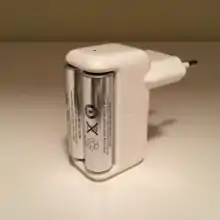Apple Battery Charger
The Apple Battery Charger is a battery charger which was sold by Apple Inc. and bundled with six AA batteries. It was introduced in July 2010 and marketed as a way to charge Apple's wireless Magic Mouse, Magic Trackpad and Apple Wireless Keyboard.[2] The charger was discontinued around 2016,[3] after Apple revised their peripherals with built-in batteries that can be charged with a Lightning connector.[4]
 A European Apple Battery Charger | |
| Also known as | A1360 |
|---|---|
| Developer | Apple Inc. |
| Type | Battery Charger |
| Release date | July 27, 2010[1] |
| Discontinued | 2016 |
| Website | Homepage at the Wayback Machine (archived 2016-01-25) |
Charger
The charger has a white design, with a small indicator light on top that glows amber while the batteries are charging, and green once they are charged. It can charge two NiMH batteries at once,[2] and takes five hours for a full charge.[5]
Apple's main marketing claim for the product was that the charger had a standby power draw of 30 mW, compared to an industry average of 315 mW.[2][6][7]
Batteries
The charger was sold with six rechargeable AA batteries that use low self-discharge NiMH technology,[8] have a silver design and no Apple branding, and have an advertised capacity of 1,900 milliampere-hour (mAh).[2] Czech website SuperApple identified the batteries as likely being rebranded Eneloop HR-3UTG 1.2 volt batteries manufactured by Sanyo.[8][9]
According to Apple, these batteries were designed to have a service life of up to ten years and retain 80% of their capacity even after being stored for a year.[10] Engadget says the Sanyo Eneloop batteries are able to retain 75% of their charge after three years.[8]
Reception
Engadget criticized Apple for selling their charger and six batteries for $29 when Sanyo sold a charger and eight batteries for the same price.[8] SuperApple noted that Apple's then-current wireless peripherals used two AA batteries, but older Apple Wireless Keyboards used three; Apple's charger could only charge two at once.[5]
Apple marketed its battery charger as environmentally friendly due to a lower standby power draw, although Massachusetts Institute of Technology engineering professor Gerbrand Ceder criticized Apple for shipping peripherals that require disposable batteries, instead of non-removable lithium-ion batteries like many of Apple's competitors.[11]
References
- Dziuban, Laura June. "Apple Battery Charger gets official: a battery charger, only you know, better (update: hands-on)". Engadget. Retrieved 29 May 2023.
- Hughes, Neil (2010-08-03). "First look: Apple Battery Charger and AA batteries". AppleInsider. Retrieved 2023-05-29.
- Rossignol, Joe (2021-10-04). "Remember Apple's AA Battery Charger? It'll Be a Vintage Product Soon". MacRumors. Retrieved 2023-05-29.
- Laporte, Christophe (2017-11-26). "Avis de disparition : le chargeur de piles Apple". MacGeneration (in French). Retrieved 2023-05-29.
- Janeček, Vláďa (11 August 2010). "Apple Battery Charger: nabíjí a svítí (Zkušenosti)". SuperApple.cz (in Czech). Retrieved 29 May 2023.
- Burns, Matt (July 27, 2010). "Apple's Innovative New… Battery Charger?". TechCrunch. Retrieved April 8, 2019.
- Bertolucci, Jeff (July 27, 2010). "Apple Battery Charger slays vampire draw". Macworld. Retrieved April 8, 2019.
- Ricker, Thomas (August 12, 2010). "Apple's rechargeable AA batteries are rebranded Sanyo Eneloops?". Engadget. Retrieved April 8, 2019.
- Janeček, Vláďa (12 August 2010). "Apple baterie a nabíječka: hloubkový pohled, který jinde neuvidíte". SuperApple.cz (in Czech). Retrieved 29 May 2023.
- Hughes, Neil (August 3, 2010). "First look: Apple Battery Charger and AA batteries". AppleInsider. Retrieved April 8, 2019.
- Worthington, David (July 27, 2010). "Apple debuts reusable battery charger". ZDNET. Retrieved 2023-05-29.